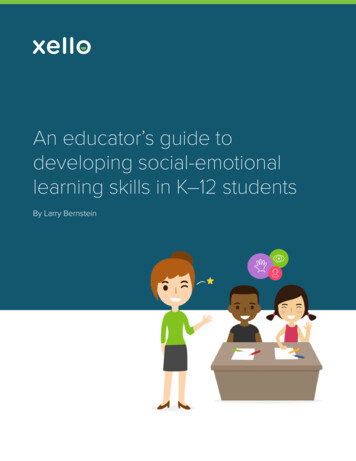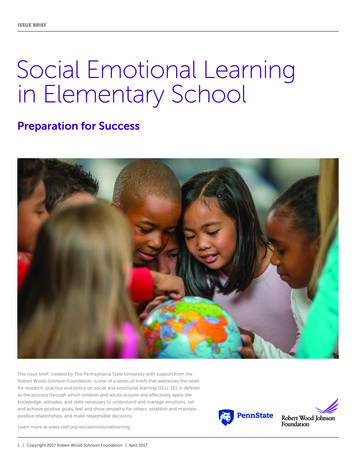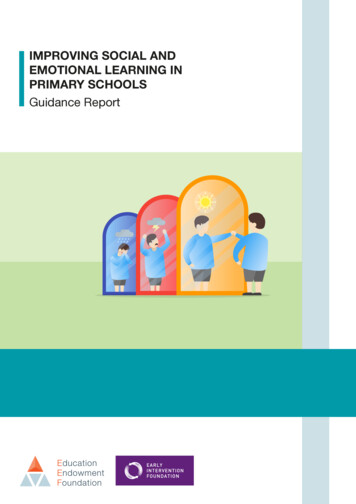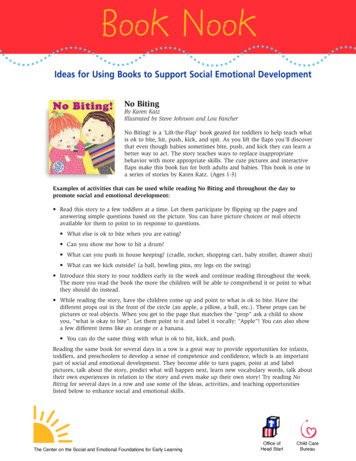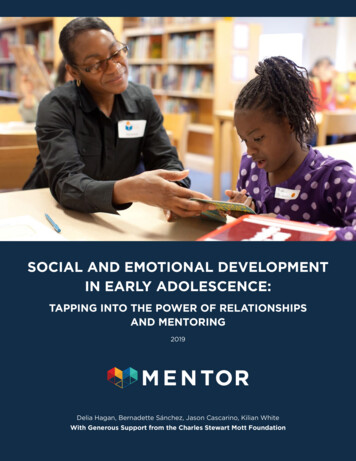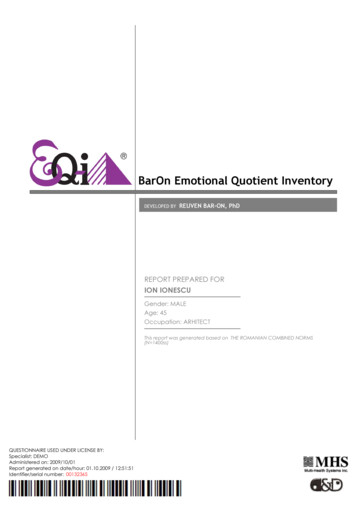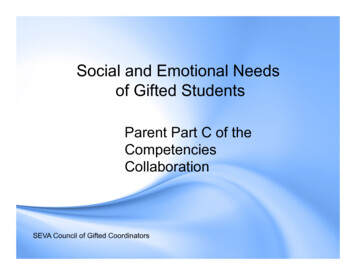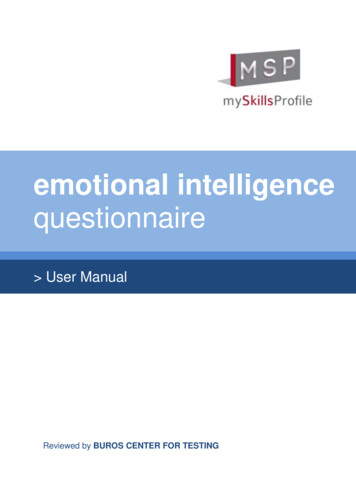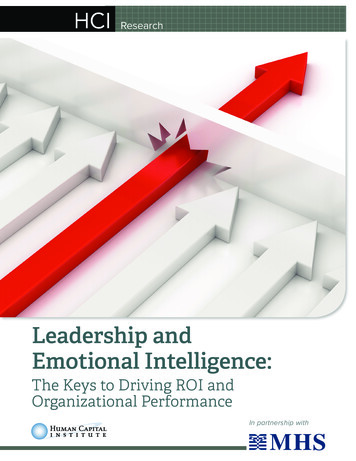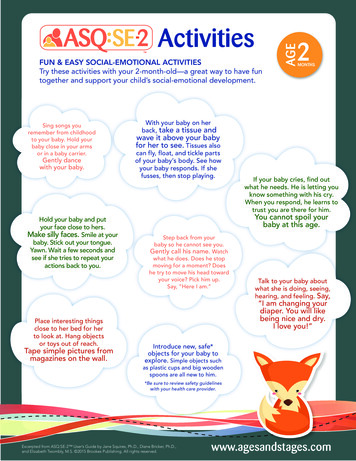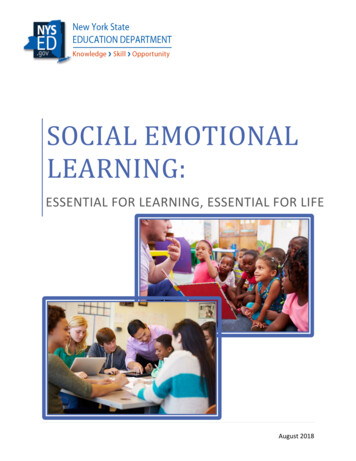
Transcription
SOCIAL EMOTIONALLEARNING:ESSENTIAL FOR LEARNING, ESSENTIAL FOR LIFEAugust 2018
2 Page
I have no doubt that the survival of the human race dependsat least as much on the cultivation of social and emotionalintelligence, as it does on the development of technicalknowledge and skills. Most educators believe that thedevelopment of the whole child is an essential responsibilityof schools, and this belief is what has motivated them toenter the profession.Linda Darling-HammondHandbook of Social and Emotional Learning: Research and Practice, 20153 Page
TABLE OF CONTENTSIntroduction . 6Social Emotional Learning Defined . 7Multi-Tiered Systems of Support . 8Equity and SEL . 10What the Research Tells Us . 11Impact of SEL on Academic Achievement . 11Impact of SEL on Personal and Behavioral Outcomes . 12Impact of Trauma on Social Emotional Development . 13National Commission on Social, Emotional, and Academic Development . 14SEL Benefits and Cost Effectiveness. 14Benefits . 14Cost Effectiveness . 15Status of SEL in New York State . 16Progress to Date. 16SEL and NYSED’s School Climate Index . 20New York State SEL Goals . 21Systemic Whole School Implementation of SEL . 22School Culture and Climate. 24Approach to Discipline . 25Instruction . 28Professional Development . 28Afterschool, Summer School and Community School Programs. 29Anticipated Barriers to Success . 29Federal Support for SEL Implementation . 30Acknowledgements. 32References . 36Appendix A: Example of Multi-Tiered System of Supports . 42Appendix B: New York State Safe Schools Task Force . 434 Page
Appendix C: New York State School Climate and Student Engagement WorkgroupRecommendations . 45Appendix D: Systemic Whole School Implementation of Social Emotional Learning . 48Appendix E: Range of Restorative Practices . 49Appendix F: Pending National Legislation . 505 Page
INTRODUCTIONThe mission of the New York State Education Department is “to raise the knowledge, skill, andopportunity of all people in New York.” In alignment with this mission, every public school seeksto graduate students who are prepared for college, career, and responsible citizenship in the 21stcentury. In addition to academic content and skill development, schools must address manycontextual factors, including physical and mental health, safety, socioeconomics, culture, and thefocus of this paper, social emotional leaning (SEL).SEL “is the process through which children, youth, and adults acquire and effectively apply theknowledge, attitudes, and skills necessary to understand and manage emotions, set and achievepositive goals, feel and show empathy for others, establish and maintain positive relationships,and make responsible decisions” (Collaborative for Academic, Social, and Emotional Learning,2015, para. 1). SEL is essential to creating schools that effectively prepare all young people tosucceed in school and in life.Extensive research indicates that effective mastery of social emotional competencies isassociated with greater well-being and better school performance; whereas the lack ofcompetency in these areas can lead to a variety of personal, social, and academic difficulties(Eisenberg, 2006; Guerra & Bradshaw, 2008; Masten & Coatworth, 1998; Weissberg &Greenberg, 1998). In fact, a study of young students found a significant relationship betweenstudents’ social emotional skills in kindergarten and their outcomes 13-19 years later. Thosestudents with early prosocial skills were more likely to graduate from high school on time,complete a college degree, and achieve and maintain full time employment. Further, during highschool they were less likely to be involved with police, abuse alcohol, or be on medication foremotional or behavioral issues (Jones, Greenberg, & Crowley, 2015).There is also evidence that explicitly teaching these skills can have a wide-ranging impact onstudents’ development. Studies have found that participating in high quality, evidence-based SELprograms can reduce emotional distress, improve engagement, improve social emotional skills,and improve academic achievement by 11 percentile points (Durlak et al., 2011).Underscoring the decisive role SEL will play in 21st century education, in the Economics andPsychology of Personality Traits, Nobel Prize winning economist James Heckman maintains thatexecutive functioning factors such as motivation, time management, and self-regulation arecritical for later life outcomes, including success in the labor market (Borghans, Duckworth,Heckman & Weel, 2008). The labor market increasingly rewards social skills; for example,between 1980 and 2012, jobs with high social skill requirements grew by nearly 10 percentagepoints as a share of the U.S. labor force (Deming, 2015).Finally, research suggests that student learning benchmarks (or standards) focusing on SEL mayincrease the likelihood that students will receive better instruction in SEL, experience improvedschool connectedness, and become better learners (Jones & Bouffard, 2012; Osher & Kendziora,2008). This sentiment is shared by teachers of students spanning all grade levels andsocioeconomic statuses. More than half of teachers in prekindergarten and elementary school,6 Page
middle school, and high school want SEL in their state standards. Furthermore, more than half ofteachers in high-poverty (68%) and low-poverty (59%) schools want SEL in their state standards(Bridgeland & Hariharan, 2013).“The issue should not be framed as a choice between intellectual and social-emotionaldevelopment, IQ [Intelligence Quotient] and EQ [Emotional Quotient], or academic and interand intrapersonal skills. Sound education requires an equivalent focus on EQ and IQ, and allschools must deal with this reality” (Elias, Arnold, & Hussey, 2003, as cited in Elias, Arnold, &Steiger, 2003, p. 308). It is, therefore, imperative for schools to incorporate social emotionallearning into their daily instructional practice with fidelity and district-wide support.This document addresses the need for social emotional learning (SEL) in New York’s schools, andserves as an introduction to a series of resources, including voluntary Social Emotional LearningBenchmarks, a Guide to Systemic Whole School Implementation (in development), and a seriesof school district-developed crosswalks aligning SEL competencies with learning standards in thecontent areas (in development).SOCIAL EMOTIONAL LEARNING DEFINEDThere are many frameworks and ways to talkabout social emotional competence and skills.For simplicity and clarity, this document uses aset of five competencies, identified by theCollaborative for Academic, Social, andEmotional Learning (CASEL) that all youngpeople (and adults) need to learn to besuccessful in school and in life. This frameworkhas been widely accepted across the country.Figure 1: Framework for Systemic Social and Emotional Learning. CASEL 2017Five Core Social Emotional CompetenciesSelfAwareness7 PageCompetence in the self-awareness domain involves understanding one’semotions, personal goals, and values. This includes accurately assessingone’s strengths and limitations, having a positive mindset, and possessing awell-grounded sense of self-efficacy and optimism. High levels of selfawareness require the ability to recognize how thoughts, feelings, andactions are interconnected.
ponsibleDecisionMakingCompetence in the self-management domain requires skills and attitudesthat facilitate the ability to regulate emotions and behaviors. This includesskills necessary to achieve goals, such as the ability to delay gratification,manage stress, control impulses, and persevere through challenges.Competence in the social awareness domain involves the ability to take theperspective of and have respect for those with different backgrounds orcultures, and to empathize and feel compassion. It also involvesunderstanding social norms for behavior and recognizing family, school, andcommunity resources and supports.Competence in this domain involves communicating clearly, listeningactively, cooperating, resisting inappropriate social pressure, negotiatingconflict constructively, and seeking help when needed. Relationship skillsprovide individuals with the tools they need to establish and maintain healthyand rewarding relationships, and to act in accordance with social norms.Competence in this domain requires the ability to consider ethical standards,safety concerns, and make accurate behavioral assessments to make realisticevaluations of the consequences of various actions, and to take the healthand well-being of self and others into consideration. Responsible decisionmaking requires the knowledge, skills, and attitudes needed to makeconstructive choices about personal behavior and social interactions acrossdiverse settings.CASEL’s inclusion of the word “learning” in the term “social emotional learning” was purposefuland designed to reflect the fact that the acquisition of the skills and attitudes within the fivecompetency domains is a process, and that schools are one of the primary places where thislearning takes place. This emphasis on learning is bolstered by more than three decades of brainresearch on neuroplasticity and the ability of all individuals to engage in lifelong learning.MULTI-TIERED SYSTEMS OF SUPPORTUsing Multi-Tiered Systems of Support (MTSS) such as Response to Intervention (RTI) and PositiveBehavioral Interventions and Supports (PBIS) enables schools to proactively provide universalinterventions for all students, and to customize interventions that address academic andbehavioral challenges for at-risk students (secondary interventions) and high need students(tertiary interventions). It is an important means of addressing equity and most importantly,ensures that all young people are provided with the kinds of supports they need to thrive.Universal interventions span a wide range of supports that include, but are not limited to thefollowing: evidence-based SEL curriculum;SEL instructional practices;8 Page
service learning opportunities;extra-curricularactivities;after school programsand expanded learningopportunities;peer tutoring;mentoring;mental and physicalwell-being workshops(e.g., suicide prevention,HIV/AIDS, substanceabuse curriculum,violence preventionprograms, yoga,mindfulness, etc.);team sports;student government; and Figure 2: Designing Schoolwide Systems for Student Success. OSEP TechnicalAssistance Center for Positive Behavioral Interventions and Support, 2017.student clubs, etc.As part of an MTSS framework, supports offered at all levels should reflect school-wideimplementation of effective, efficient, and evidence-based practices and strategies that allstudents can access. The supports represented in the universal tier are foundational to secondaryand tertiary supports. Effective Universal Interventions alone should be effective forapproximately 80% of students.Infusing SEL through all facets of school life is a universal intervention that all other academic andbehavioral interventions can and should build upon. At the secondary and tertiary levels,supports become increasingly targeted to meet students’ specific needs. At the secondary level,these supports may be provided by school counselors, other professional support staff, oroutside agencies and are targeted to students identified as “at-risk” in the form of individualcounseling or small group meetings (e.g., social skills groups, lunch bunch); and/or individualizedprograms that are not clinical in nature (e.g., Primary Project). At the tertiary level, a smallnumber of high need students with more severe mental health needs may require clinicalinterventions, one-on-one counseling, and referral to community resources. (Please seeAppendix A: Example of a Multi-Tiered System of Supports.9 Page
EQUITY AND SELStudents of color, students with disabilities and learning differences, English language learners,lesbian, gay, bisexual, transgender and questioning or queer (LGBTQ) youth, and others continueto face challenges such as disproportionately low achievement rates compared to the generalstudent population, and/or disproportionately higher discipline rates for the same or similaroffenses (Annie E. Casey Foundation, 2017; Gregory & Fergus, 2017). Additionally, referrals tospecial education disproportionately target students of color (Eccles, Wong, & Peck, 2006, ascited in Gregory & Fergus, 2017). Other student subgroups also experience disparities thatnegatively impact their access to equitable education. As educators, it is our responsibility tonavigate the varied and complex causes of educational inequity and work to close these gaps.We must ensure that all students receive the supports they need to achieve in academics and lifeand are treated equitably under discipline policies. SEL can help us achieve these goals in multipleways.Implicit bias stands as a major obstacle to achieving equity in education, but increasing SELcompetencies can help us to manage it. Implicit biases are the unconscious stereotypes andattitudes we hold toward particular groups (Godsil, et al., 2017). Unlike explicit biases, which areconsciously held beliefs, implicit biasesoften exist without our knowledge,and can negatively impact theWhen schools commit to promoting students’students we serve, despite our bestintentions.social-emotional learning, they becomepositioned to engage all educationTo reduce implicit bias, we must firststakeholders and create a safe, equitable, andconfront the biases we hold withinengaging school climate, so each studentourselves (self-awareness). Biases arenormal and natural, a result of ouracquires and enhances the knowledge, skills,experience and exposure, and are heldand dispositions they need for interpersonalby even the most well-meaning amongand life success.us. By developing an awareness of andbetter understanding our own biases,Duffell, Elias, & Pickeral, 2017we can then work to manage them(self-management) and mitigate theirinfluenceonourattitudes,actions/behaviors, and decisions, as well as those of our students (social awareness, relationshipskills, and responsible decision-making).Culturally Responsive Practices (CRP) requires skill in all SEL competencies and has been shownto be effective in improving student academic performance and life opportunities across contentareas (Farinde-Wu, Glover, & Williams, 2017). CRP means relating all aspects of teaching andlearning within the context of a student’s cultural identity and experience. CRP sees studentsfrom an assets-based perspective and leverages their cultural context to make learning relevantand increase engagement (M. Hurley, interview, May 2017).10 P a g e
Increasing equity in our schools requires an integrated and organized tiered system of supportswith a strong foundation in SEL, an organization committed to honest self-reflection andawareness, and a protocol for policy review and development that consciously works to adhereto best practices to meet the needs of all students.New York State’s ESSA Plan places heavy emphasis on cultural and linguistic competence andresponsiveness. NYSED’s Blueprint for English Language Learner Success and the Blueprint forImproved Results for Students with Disabilities lay the foundation for success for these specialpopulations. Through these frameworks, New York State strives to ensure that all students’individual educational paths and socio-emotional needs are met in multiple languages leadingthem to college, career, and civic readiness and that all educators are knowledgeable and skilledin providing explicit instruction in academics and SEL.Equity, implicit bias, CRT, and SEL are inextricably intertwined. Increasing SEL competencies inour systems, ourselves, and our students can assist our efforts to decrease implicit bias andincrease cultural responsiveness, thereby increasing equity for our students.WHAT THE RESEARCH TELLS USIMPACT OF SEL ON ACADEMIC ACHIEVEMENTSocial emotional competency impacts young people’s academic achievement. In their 2005longitudinal study Self-Discipline Outdoes I.Q. in Predicting Academic Performance inAdolescence, Duckworth and Seligman (2005) found that “self-discipline measured by self-report,parent report, teacher report, and multiple-choice questionnaires in the fall predicted finalgrades, school attendance, standardized achievement-test scores, and selection into acompetitive high school program the following spring.”A meta-analysis of 213 rigorous studies of SEL in K-12 schools (across urban, rural, and suburbansettings), (Durlak et al., 2011) indicated that students receiving quality SEL instructiondemonstrated the following:Social and Emotional Learning Meta-Analysis FindingsBetter AcademicPerformanceImproved Attitudesand BehaviorsFewer NegativeBehaviorsReduced EmotionalDistress11 P a g eachievement scores an average of 11 percentile points higher thanstudents who did not receive SEL instructiongreater motivation to learn, deeper commitment to school,increased time devoted to schoolwork, and better classroombehaviordecreased disruptive class behavior, including noncompliance,aggression, delinquent acts, and disciplinary referralsfewer reports of student depression, anxiety, stress, and socialwithdrawal
Social, emotional, and cognitivedevelopment are deeply intertwined andtogether are integral to academic learningand success.In addition, the meta-analysis found thatschool-based programs conducted byschool staff (e.g. teachers, as opposed tooutside providers) are most effective,indicating that they can be incorporatedinto routine educational practice.Jones and Kahn, 2017The longitudinal effects of the eightoriginal SEL programs that measuredacademics were assessed in 2017 (i.e.Taylor, Oberle, Durlak & Weissberg), and it was found that students involved in SEL programs hadacademic performance an average of 13 percentile points higher than peers who had not beenexposed to SEL programs.Students participating in the Promoting Alternative Thinking Strategies (PATHS) curriculum wereshown to be more likely to achieve proficiency in reading, writing, and math in some grade levelsthan a non-participating control group (Schonfeld et al., 2014). Positive academic outcomes inmath and reading outcomes were found to be partially a result of increased classroom emotionalsupport and organization following implementation of the SEL program INSIGHTS (McCormick,Cappella, O’Connor, & McClowry, 2015). With these and other additions, the research baselinking SEL interventions to improved academic outcomes is growing.IMPACT OF SEL ON PERSONAL AND BEHAVIORAL OUTCOMESYoung people who fail to achieve adequate social emotional competence have a higherprobability of experiencing a lack of academic success, and of being at-risk throughoutadolescence and adulthood (Hartup, 1992; Ladd, 2000).In one study, researchers found significant relationships between students’ social emotional skillsin kindergarten, as assessed by teachers, and control group outcomes 13-19 years later forindividuals that did not receive a specific set of intervention services titled, “Fast Track.” Thosewith early prosocial skills were less likely later in life to receive public assistance, be involved withthe police, abuse alcohol, and be on medication for emotional or behavioral issues through highschool. The same study also found that those with early prosocial skills were more likely tograduate from high school on time, complete a college degree, and get and keep full-timeemployment (Jones, Greenberg & Crowley, 2015). Other researchers have found similar effectsof social emotional skills on long-term outcomes such as financial well-being, physical health, andsubstance use (Moffitt et al., 2011). Implementation of SEL interventions for all students canimprove prosocial skills and help reduce negative outcomes.12 P a g e
IMPACT OF TRAUMA ON SOCIAL EMOTIONAL DEVELOPMENTResearch addressing the impact of Adverse Childhood Experiences (ACEs) and trauma on youngpeoples’ ability to learn and school outcomes clearly supports the need for educators and thecommunity to better understand the issues some young people face and to ensure that all youngpeople go to schools that provide supportive learning environments.Since 2009, multiple states have used the Youth Risk Behavior Surveillance System to collectinformation about ACEs. The ACE score, a total sum of the different types of ACEs reported byparticipants, is used to assess cumulative childhood stress. Study findings repeatedly reveal thatas the number of ACEs increases, so does the risk for multiple physical health conditions andother factors including risk behaviors (i.e., smoking, alcoholism, drug use), mental distress,depression, mortality, and life potential, such as lowered educational attainment, and lost timefrom work and unemployment (Centers for Disease Control and Prevention, 2016).ACEs can affect students’ attention, processing of information, memory, and learning, underminethe development of language and communication skills, thwart the establishment of a coherentsense of self, compromise the ability to attend to classroom tasks and instructions, interfere withthe ability to organize and remember new information, and hinder a student’s grasp of causeand-effect relationships, all of which are necessary to process information effectively.Neurobiological changes in the brains of young people exposed to severe and/or persistenttrauma leave them in a constant state of stress in which they are highly susceptible to “triggers”in their environment.It is especially important that educators are mindful of these factors when they respond tostudents’ behavior and proactively provide scaffolds within the learning environment. Adultreactions must provide appropriate support to mitigate inappropriate behavior and avoidexacerbating existing challenges. As a result, many teachers, specialized instructional supportstaff, pupil personnel services, and school health personnel are increasingly implementingtrauma-informed practices such as those found in the National Center for Traumatic StressNetwork toolkit for educators from preschool to high school.SEL begins at home and must be purposefully nurtured and supplemented through supportiveschool and classroom environments that offer opportunities for explicit instruction in relatedskills and opportunities for practice. SEL is a developmental process that takes place beginning atbirth and continues through adulthood. Even when young people receive excellent support fortheir social emotional development at home, there must be collaboration between schoolpersonnel, family members, and community resources to create a network of support forfostering social emotional competencies in young people. These skills are continually developedthrough classroom instruction, various school activities and support services, as well as by afterschool, extracurricular, and service learning programs.13 P a g e
NATIONAL COMMISSION ON SOCIAL, EMOTIONAL, AND ACADEMIC DEVELOPMENTIn September 2016, the Aspen Institute convened a National Commission on Social, Emotional,and Academic Development co-chaired by Linda Darling-Hammond, Tim Shriver and GovernorJohn Engler. “Over the next two years, this Commission will sponsor the most importantconversation in a generation about what constitutes success for our schools and our students.The Commission will forge a unified voice among researchers, educators, practitioners, andpolicymakers about the urgency of making social emotional development an essentialcomponent of K-12 education. Through an inclusive and deliberative process, the Commissionwill develop a roadmap with specific action steps in research, practice, and policy that will pointthe way toward a new era of education ― one that addresses the needs of the whole student.”(ASPEN Institute)SEL BENEFITS AND COST EFFECTIVENESSBENEFITSAt both the Berkshire Jr/Sr HS and the Warren Street Academy the inclusion ofSocial Emotional Learning concepts has had a profound impact. Students havedeveloped a greater sense of empathy, leading to a greater amount of respect forboth peers and faculty which has resulted in less behavioral incidents. Faculty havegained a deeper understanding of the negative impact that trauma has on theirstudents. This change in dynamic has greatly increased the positive relationshipsin the classroom which has resulted in improved academic outcomes.Bruce Potter, SuperintendentBerkshire Union Free School DistrictWhen school leaders consider opportunities for improving learning environments, they want tounderstand how the school will benefit. To answer this question, each school community mustask the following: Is improving academic performance a school goal?Is improving the overall well-being and success of students a school goal?Does the comprehensive school improvement plan focus on improving attendance orproviding a more safe and healthy learning environment?Does the professional development plan include classroom management strategies andskills to increase the capacity of teachers to effectively address disruptive studentbehavior?Is reducing inappropriate student behavior a school goal?Does the school allocate substantial staff and financial resources to address these issues?14 P a g e
Like health care facilities and other human services organizations, schools must weigh the costsof their professional practice in terms of human as well as economic costs, short- and long-term.When considering the implementation of SEL, each school needs to consider the costs (i.e.,human, instructional, and financial) related to each of the following questions: How much instructional time is lost to unfocused or disruptive behavior in the classroom?How many school staff member and school leader hours are spent in any given week inthe following:o Responding to students’ social emotional needs?o Addressing noncompliance and/or misconduct?o Working to convince students that their success in school is important now and inthe future?In any given week, how much time and effort are spent by various school staff membersand school leaders in the following:o Getting and keeping students in school?o Providing counseling and support services?o Addressing bullying behavior?o Handling the aftermath of student-to-student conflicts?o Dealing with the impact of negative student and staff relations?o Processing and resolving disciplinary referrals?o Dealing with staff attendance issuesIf significant time is spent addressing one or more of these issues, then the school has everythingto gain by incorporating SEL into its daily practice.COST EFFECTIVENESSStudents of all abilities and backgrounds benefit from opportunities to develop their socialemotional skills. In February 2015, the Center for Benefit-Cost Studies of Education at ColumbiaUniversity’s Teachers College released the findings of The Ec
programs can reduce emotional distress, improve engagement, improve social emotional skills, and improve academic achievement by 11 percentile points (Durlak et al., 2011). . social skills groups, lunch bunch); and/or individualized programs that are not in nature (e.g., Primary Project). At the tertiary level, a small clinical
